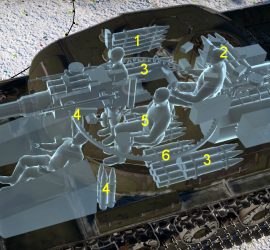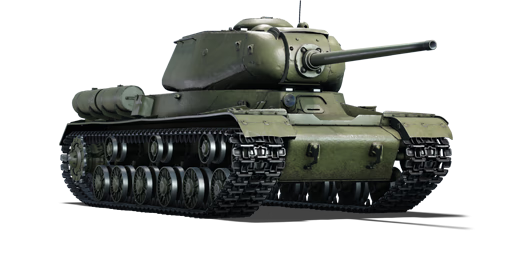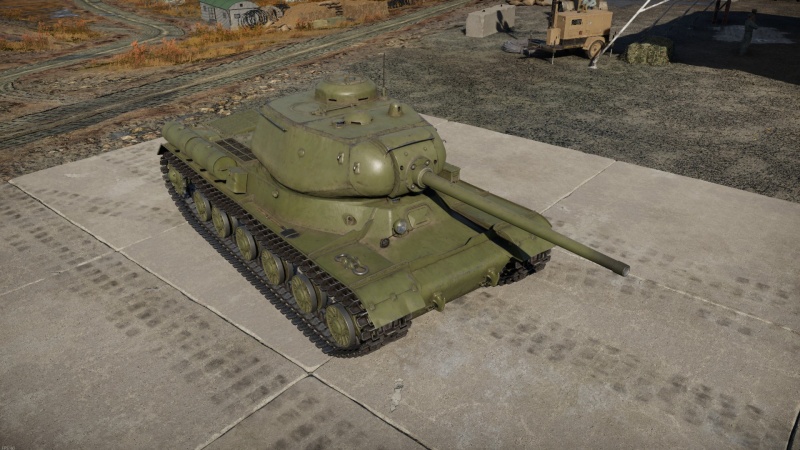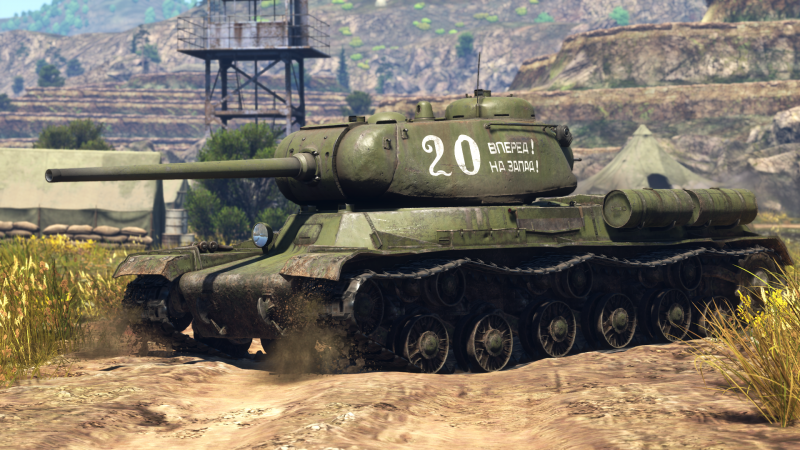Difference between revisions of "IS-1"
m (Added a new Specs-Card thumbnail) |
Colok76286 (talk | contribs) (Edits) |
||
| Line 150: | Line 150: | ||
<!-- ''Describe the tactics of playing in the vehicle, the features of using vehicles in the team and advice on tactics. Refrain from creating a "guide" - do not impose a single point of view but instead give the reader food for thought. Describe the most dangerous enemies and give recommendations on fighting them. If necessary, note the specifics of the game in different modes (AB, RB, SB).'' --> | <!-- ''Describe the tactics of playing in the vehicle, the features of using vehicles in the team and advice on tactics. Refrain from creating a "guide" - do not impose a single point of view but instead give the reader food for thought. Describe the most dangerous enemies and give recommendations on fighting them. If necessary, note the specifics of the game in different modes (AB, RB, SB).'' --> | ||
| − | As the tank's design purpose suggests, the IS-1 is a heavy tank built with an emphasis on engaging hostile armoured vehicles as well as a breakthrough tank. The tanks heavy armour has similar properties of its previous KV-1 line, but the introduction of sloped armour on the front plate and turret mantlet can allow operators to withstand a significant amount of damage at most ranges, especially when armour is angled. The fast reloads speed of the | + | As the tank's design purpose suggests, the IS-1 is a heavy tank built with an emphasis on engaging hostile armoured vehicles as well as a breakthrough tank. The tanks heavy armour has similar properties of its previous KV-1 line, but the introduction of sloped armour on the front plate and turret mantlet can allow operators to withstand a significant amount of damage at most ranges, especially when armour is angled. The fast reloads speed of the 85 mm gun (on par with its T-34 and KV-85 mounted sisters) also allows it to be an effective brawler in close quarters combat against multiple targets. When encountering better-protected targets, the IS tank (although equipped with the same type of cannon) has access to APCR rounds to better deal with heavier opponents, something the KV and T-34 models lack. |
Although classified as a heavy tank and an upgraded improved design over the KV predecessor, the tank is not invulnerable. The vehicle's armour thickness is quite effective in its class. Unlike its Tiger rivals and KV predecessors, the IS-1 has better or equal thickness armour on almost all sides except the rear hull and is sloped increasing the chance of ricochet and damage reduction when struck. Of note is the large turret and exposed turret mount which is commonly targeted at engaging hostile vehicles from the front. Armaments and ammunition options aside, the IS tank can perform similarly if not better at engaging targets than the common T-34, albeit with more satisfactory armour protection, able to allow users to lead a charge from the front with relative confidence or provide fire support from the sides or rear. This tank is quite sufficient in holding its own on the battlefield in many situations where a lighter vehicle cannot. | Although classified as a heavy tank and an upgraded improved design over the KV predecessor, the tank is not invulnerable. The vehicle's armour thickness is quite effective in its class. Unlike its Tiger rivals and KV predecessors, the IS-1 has better or equal thickness armour on almost all sides except the rear hull and is sloped increasing the chance of ricochet and damage reduction when struck. Of note is the large turret and exposed turret mount which is commonly targeted at engaging hostile vehicles from the front. Armaments and ammunition options aside, the IS tank can perform similarly if not better at engaging targets than the common T-34, albeit with more satisfactory armour protection, able to allow users to lead a charge from the front with relative confidence or provide fire support from the sides or rear. This tank is quite sufficient in holding its own on the battlefield in many situations where a lighter vehicle cannot. | ||
| Line 211: | Line 211: | ||
;Skins | ;Skins | ||
| − | + | * [https://live.warthunder.com/feed/camouflages/?vehicle=ussr_is_1 Skins and camouflages for the {{PAGENAME}} from live.warthunder.com.] | |
| − | * [ | ||
;Videos | ;Videos | ||
Revision as of 00:37, 24 October 2022
Contents
Description
The IS-1 is a rank III Soviet heavy tank with a battle rating of 5.7 (AB/RB/SB). It was introduced during the closed beta testing for Ground Forces before Update 1.41. It is the first unlockable IS series heavy tank.
Operational and visual characteristics of the IS-1 retain the visual and operational similarities to the previous KV line of heavy tanks of which it is descended from. Players experienced in operating previous models of the KV series of tanks should have little to no difficulty in adjusting to this vehicle. Unlike its predecessor, the IS series of tanks are designed with a priority of engaging enemy armoured vehicles in mind and as such, come with increased yet more sloped armour than its KV predecessors whilst sporting a slightly longer chassis, more powerful 85 mm D-5T gun and a larger, rounded turret.
General info
Survivability and armour
Armour type:
- Cast homogeneous armour (Front hull, Turret)
- Rolled homogeneous armour (Rear hull, Gun mantlet)
| Armour | Front | Sides | Rear | Roof |
|---|---|---|---|---|
| Hull | 120 mm (35°) Front plate 60 mm (75°) Front glacis 100 mm (28-36°) Lower glais |
100 mm (11-27°)Top front 90 mm (11°) Top rear 90 mm Bottom |
60 mm (48°) Top 60 mm (35°) Lower |
30 mm |
| Turret | 100 mm (0-89°) Turret front 100 mm (4-59°) Gun mantlet |
100 mm (19-21°) | 100 mm (2-36°) | 30 mm 35 mm Turret hatches |
| Cupola | 90 mm | 90 mm | 90 mm | 35 mm |
Notes:
- Suspension wheels are 20 mm thick and tracks are 30 mm thick.
- Though the front plate is 120 mm thick, it is not very sloped in comparison to the front glacis. Despite front glacis, 60 mm thickness, slope effect up to ~130 mm and ricochet chances improve protection.
Mobility
| Game Mode | Max Speed (km/h) | Weight (tons) | Engine power (horsepower) | Power-to-weight ratio (hp/ton) | |||
|---|---|---|---|---|---|---|---|
| Forward | Reverse | Stock | Upgraded | Stock | Upgraded | ||
| Arcade | 40 | 16 | 44 | 671 | 992 | 15.25 | 22.55 |
| Realistic | 38 | 15 | 460 | 520 | 10.45 | 11.82 | |
Modifications and economy
Armaments
Main armament
| 85 mm D-5T | Turret rotation speed (°/s) | Reloading rate (seconds) | |||||||||||
|---|---|---|---|---|---|---|---|---|---|---|---|---|---|
| Mode | Capacity | Vertical | Horizontal | Stabilizer | Stock | Upgraded | Full | Expert | Aced | Stock | Full | Expert | Aced |
| Arcade | 59 | -5°/+25° | ±180° | N/A | 11.33 | 15.68 | 19.04 | 21.06 | 22.40 | 9.62 | 8.51 | 7.84 | 7.40 |
| Realistic | 8.33 | 9.80 | 11.90 | 13.16 | 14.00 | ||||||||
Ammunition
| Penetration statistics | |||||||
|---|---|---|---|---|---|---|---|
| Ammunition | Type of warhead |
Penetration @ 0° Angle of Attack (mm) | |||||
| 10 m | 100 m | 500 m | 1,000 m | 1,500 m | 2,000 m | ||
| BR-365K | APHE | 148 | 143 | 126 | 106 | 90 | 77 |
| BR-365A | APHEBC | 135 | 133 | 124 | 114 | 104 | 95 |
| BR-365P | APCR | 195 | 187 | 154 | 122 | 96 | 76 |
| O-365K | HE | 11 | 11 | 11 | 11 | 11 | 11 |
| Shell details | |||||||||
|---|---|---|---|---|---|---|---|---|---|
| Ammunition | Type of warhead |
Velocity (m/s) |
Projectile mass (kg) |
Fuse delay (m) |
Fuse sensitivity (mm) |
Explosive mass (TNT equivalent) (g) |
Ricochet | ||
| 0% | 50% | 100% | |||||||
| BR-365K | APHE | 792 | 9.2 | 1.2 | 14 | 73.92 | 47° | 60° | 65° |
| BR-365A | APHEBC | 792 | 9.2 | 1.2 | 14 | 164 | 48° | 63° | 71° |
| BR-365P | APCR | 1,050 | 4.99 | N/A | N/A | N/A | 66° | 70° | 72° |
| O-365K | HE | 793 | 9.54 | 0 | 0.1 | 741 | 79° | 80° | 81° |
Ammo racks

| Full ammo |
1st rack empty |
2nd rack empty |
3rd rack empty |
4th rack empty |
5th rack empty |
6th rack empty |
Visual discrepancy |
|---|---|---|---|---|---|---|---|
| 59 | 55 (+4) | 37 (+22) | 27 (+32) | 21 (+38) | 11 (+48) | 1 (+58) | No |
Notes:
- As they are modeled by sets of 2, shells disappear from the rack only after you've fired both shells in the set.
- Turret empty: 37 (+22) shells.
Machine guns
| 7.62 mm DT | ||||
|---|---|---|---|---|
| Mount | Capacity (Belt) | Fire rate | Vertical | Horizontal |
| Coaxial | 1,890 (63) | 600 | N/A | N/A |
Usage in battles
As the tank's design purpose suggests, the IS-1 is a heavy tank built with an emphasis on engaging hostile armoured vehicles as well as a breakthrough tank. The tanks heavy armour has similar properties of its previous KV-1 line, but the introduction of sloped armour on the front plate and turret mantlet can allow operators to withstand a significant amount of damage at most ranges, especially when armour is angled. The fast reloads speed of the 85 mm gun (on par with its T-34 and KV-85 mounted sisters) also allows it to be an effective brawler in close quarters combat against multiple targets. When encountering better-protected targets, the IS tank (although equipped with the same type of cannon) has access to APCR rounds to better deal with heavier opponents, something the KV and T-34 models lack.
Although classified as a heavy tank and an upgraded improved design over the KV predecessor, the tank is not invulnerable. The vehicle's armour thickness is quite effective in its class. Unlike its Tiger rivals and KV predecessors, the IS-1 has better or equal thickness armour on almost all sides except the rear hull and is sloped increasing the chance of ricochet and damage reduction when struck. Of note is the large turret and exposed turret mount which is commonly targeted at engaging hostile vehicles from the front. Armaments and ammunition options aside, the IS tank can perform similarly if not better at engaging targets than the common T-34, albeit with more satisfactory armour protection, able to allow users to lead a charge from the front with relative confidence or provide fire support from the sides or rear. This tank is quite sufficient in holding its own on the battlefield in many situations where a lighter vehicle cannot.
Another significant note of this vehicle is its considerably fast reverse rate, the highest of its Rank and Battle-Rating for the nation's faction, topping at 17 km/h. During situations where close-quarters engagement is expected, an unorthodox strategy can be utilized when the operator of the IS tank re-positions the vehicle 90 degrees and drive in reverse towards the enemy. By driving in reverse with the rear-facing the opposition, the engine blocks make a crude yet somewhat effective shield and protecting the more delicate crew. As the fuel tanks are mostly stored at the front on the left and right side of the driver's station, the risk of fire and fuel-tank explosion is reduced significantly (but not completely eliminated) and thus, the tank is able to resist even the most powerful of shots. Be aware that more experienced players may attempt to instead fire at the more exposed turret of the IS tank and instantly knocking out the crew with a common APHE penetrating the shell.
When engaging the common Tiger tank and Panzer IV models, each of these vehicles retains the design flaw of 90 degree flat armour plates on the front and sides of each respective vehicle. The IS-1's 85 mm cannon should have little no difficulty in penetrating this and destroying the opposition's vehicle in a single shot if this weakness is exploited. The Panther and occasional Tiger II models are more considerably dangerous and difficult to dispatch when encountering them head-on due to the thicker and sloped armour of which the 85 mm cannon of the IS-1 cannot penetrate. In head-on engagements, operators of this vehicle should note to precisely target the right and left side turret mantlet of each respective vehicles instead. Time expended in attempting to find a penetration confirmation indication on the cross-hair when inspecting the sloped front plate is time wasted and instead, should be diverted on precise targeting of the mantlet. Other more common tanks such as opposition USSR KV, IS and T-34 models are usually less of a concern than the common Panther tank, as most of these respective tanks also inherit the weakness of somewhat slopped frontal chassis and turret armour which can be easily penetrated even from significant distances with a precise aim.
If you are to apply bushes onto the IS-1, consider putting most of them on upper frontal hull and the curved sides next to it. This is because that quite some opponents will automatically target the curved armour, knowing that area is a common weak spot when the IS is angling. By covering up the hull front and the curves, the IS's frontal hull will now look flatter, somewhat resembling the hull of an IS-2 1944. This will cause some confusion and delay the enemy's reaction & aiming time, as they now cannot directly see where your curved armour is, gifting you a precious few seconds before they open fire. For any leftover bushes, the turret front and the lower front plate are also good spots to put them on.
Pros and cons
Pros:
- Good armour
- Extremely durable against in down-tiered battles (when encountering lower rank M4 Shermans, Valentines, Pz.IV etc.)
- Re-positioning of fuel tanks reducing chances of fires.
- Good mobility with a fast reverse speed
- Sufficient firepower
- High rate of fire
- Ability to fire APCR
- Player skill compatibility between older and newer KV and IS models
Cons:
- Large tank (slightly longer than the KV-1)
- Difficult to angle armour due to weaker hull cheeks
- Turret cheeks are easy to penetrate even at long distance
- Commander cupola is a big weak spot
- Poor gun depression (a common trait in all Soviet tanks)
History
Development
The start of the development for a new heavy tank in the Red Army came from the many criticisms of their current heavy tank, the KV-1. The KV-1 had poor mobility and a lack of firepower and armour advantage over the standard T-34, plus the KV-1 was more expensive to produce for no real advantage. Attempts to remedy this problem produced the KV-1S and the KV-85, which tried to make the KV-1 more mobile, more ergonomic, and have better firepower. Though they were improvements over the original KV-1 design, it was already determined that the KV-1 designs are to be replaced by a new heavy tank design and the newer KV-1 developments were to be interim designs until the heavy tank development is complete.
The heavy tank project, code-named Object 237, had its basis from the cancelled KV-13 program and was restarted from the discovery of the Tiger I after one was captured in Leningrad, thus it began in January 1943. However, despite the ensuing development, the intense tank fighting in 1943 in Kursk and ensuing operations forced the Object 237 to see action early, with its turret used on the KV-85, which itself was built atop the KV-1S hull. The turret mounted the new 85 mm D-5T gun and would be a great firepower advantage enjoyed by the Soviet tank forces as it gave them a heavy tank with comparable firepower to the Tiger I's 88 mm cannon. At the end of 1943, the Object 237 project was finished and was accepted into service as the IS-85, or the IS-1, named after Iosef (Joseph) Stalin, the current leader of the Soviet Union during World War II, putting an end to the Voroshilov (KV) line of tanks. The IS-1 began to be delivered in October 1943 and went into service in the same month. The IS-1 stayed in service until January 1944, when its production also ended with about 200 units produced.
Combat usage
The IS-1, like the KV-85 before it, was a great assist to the Soviet tank forces, giving them a heavily armoured tank with a great 85 mm gun that could defeat most of the German tanks in service except their heaviest ones such as the Tiger I and the Panther tanks. The IS-1 was issued to Guards Heavy Tank Regiments for service, most notably the 1st, 8th, and 13th Guards Heavy Tank Regiments which saw service in Ukraine and Slovakia. Within a standard IS-1 issue tank, there were often 59 85 mm rounds and 2,500 rounds for the three DT machine guns, which allowed it to have both superior armaments and capacity compared to the standard Tiger I.
The IS-1 had a short-lived production due to advances in Soviet tank technology. Their standard T-34 medium tanks were upgraded with the same 85 mm gun on the IS-1 into the T-34-85. The lack of firepower advantage the IS-1 now presented due to this upgrade prompted an up-gunning of the IS tank with a much bigger gun. After further development in late 1943, the IS-1 evolved into the IS-2, which has the larger and much more powerful 122 mm A-19 gun.
In-game description
The IS-1 was developed in the spring and summer of 1943 by factory No. 100's design bureau led by Z.Y. Kotin. The tank's hull design and overall layout were taken from the previously developed experimental KV-13 tank. The main priority was creating reliable protection against the German 88 mm Flak 18 artillery cannon and making considerable mobility improvements by reducing the tank's mass and introducing a new epicyclic gearbox. The results of battles in 1943 revealed the need for a new heavy assault tank to replace the outdated mass-produced KV tanks. The prototype, designated IS, was built, tested and put into service in the Red Army in July-September 1943. Thanks to its new gearbox and the more streamlined placement of its strengthened armour, the new tank possessed superior mobility.
The IS's tight layout in its habitable section meant that a fifth crew member - the gunner/radio officer - would not fit inside. His duties were distributed between the commander and the driver.
Three crew were housed in the turret: the tank commander and the driver worked to the left of the gun, and the loader to the right. A command cupola with 82 mm thick vertical armour was installed in the tank's turret, and its hull had a hatch leading to the underside of the tank to allow the crew to evacuate in an emergency.
The IS-1 was armed with an 85 mm D-5T Mod. 1943 tank cannon and three machine guns.
It entered mass production in October 1943 at the ChKZ factory. In total, 130 of them were built.
The IS-1 was deployed in battles from February 1944 up to and including the winter of 1945. The results of these battles led to the conclusion that the armament and armour of the new tank were not equal to those of German heavy tanks. At that time, it was recommended that the shape and armour of the frontal hull be changed and the tank's armament upgraded immediately.
Media
- Skins
- Videos
See also
Links to the articles on the War Thunder Wiki that you think will be useful for the reader, for example:
- reference to the series of the vehicles;
- links to approximate analogues of other nations and research trees.
External links
References
| Chelyabinsk Tractor Plant (Челябинский тракторный завод) | |
|---|---|
| IFVs | |
| BMP-1 | BMP-1 |
| Heavy Tanks | |
| KV | KV-85 · KV-122 |
| IS-1/2 | IS-1 · IS-2 · IS-2 (1944) · IS-2 "Revenge" · IS-2 No.321 |
| T-10 | T-10A · T-10M |
| Other IS Tanks | IS-3 · IS-4M |
| Tank Destroyers | |
| KV Derivatives | SU-152 |
| IS Derivatives | ISU-152 · ISU-122 · ISU-122S · Object 268 |
| Export | |
| IS-2 | ␗IS-2 · IS-2 No.402 · ␗IS-2 (1944) |
| ISU | ␗ISU-152 · ␗ISU-122 |
| IFVs | SPz BMP-1 |
| See Also | Leningrad Kirov Plant |
| USSR heavy tanks | |
|---|---|
| KV-1 | KV-1 (L-11) · KV-1 (ZiS-5) · KV-1E · KV-1S |
| KV-2 | KV-2 (1939) · KV-2 (1940) · KV-2 (ZiS-6) |
| Other KVs | KV-85 · KV-122 · KV-220 |
| IS-1/2 | IS-1 · IS-2 · IS-2 (1944) · IS-2 No.321 · IS-2 "Revenge" · Object 248 |
| Other IS tanks | IS-3 · IS-4M · IS-6 · IS-7 |
| T-10 | T-10A · T-10M |
| Multi-turreted | T-35 · SMK |
| Other | Object 279 |
| Lend-Lease | ▂MK-II "Matilda" |






